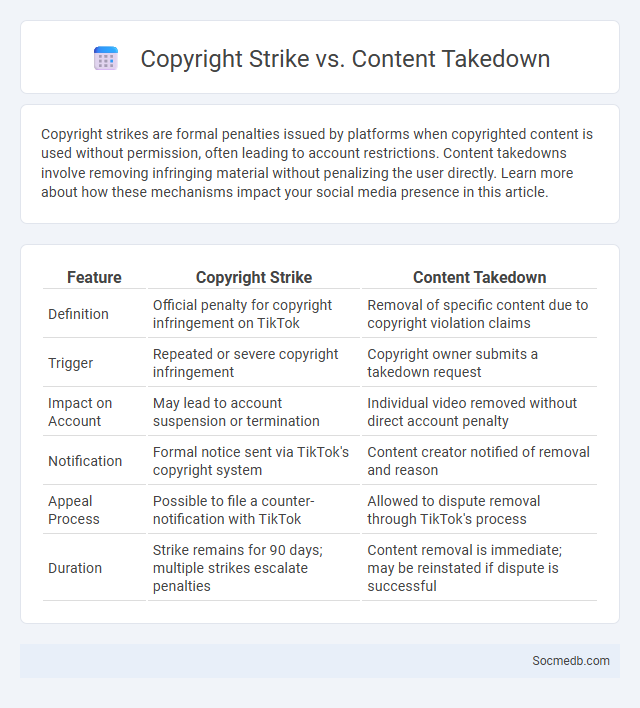
Photo illustration: Copyright Strike vs Content Takedown
Copyright strikes are formal penalties issued by platforms when copyrighted content is used without permission, often leading to account restrictions. Content takedowns involve removing infringing material without penalizing the user directly. Learn more about how these mechanisms impact your social media presence in this article.
Table of Comparison
| Feature | Copyright Strike | Content Takedown |
|---|---|---|
| Definition | Official penalty for copyright infringement on TikTok | Removal of specific content due to copyright violation claims |
| Trigger | Repeated or severe copyright infringement | Copyright owner submits a takedown request |
| Impact on Account | May lead to account suspension or termination | Individual video removed without direct account penalty |
| Notification | Formal notice sent via TikTok's copyright system | Content creator notified of removal and reason |
| Appeal Process | Possible to file a counter-notification with TikTok | Allowed to dispute removal through TikTok's process |
| Duration | Strike remains for 90 days; multiple strikes escalate penalties | Content removal is immediate; may be reinstated if dispute is successful |
Understanding Copyright Strike: Definition and Purpose
A copyright strike on social media occurs when a platform removes or restricts content due to a copyright infringement claim filed by the content owner, aimed at protecting intellectual property rights. This mechanism serves to enforce copyright laws by penalizing users who upload unauthorized material, ensuring original creators maintain control over their work. The purpose of a copyright strike also includes deterring repeated violations, which can lead to account suspensions or permanent bans on platforms like YouTube, Facebook, and Instagram.
What is a Content Takedown? Key Differences Explained
A content takedown is the removal of digital material from social media platforms due to copyright infringement, harmful content, or violation of community guidelines. Key differences include voluntary takedowns initiated by content owners and forced takedowns mandated by platforms or legal authorities. Understanding your rights and the platform's policies helps you navigate the process effectively.
Sound Copyright: Protecting Audio and Music Rights
Protecting your audio and music rights on social media is essential to avoid unauthorized use and potential legal issues. Sound copyright ensures that artists and content creators retain control over their original works, safeguarding their revenue streams and creative integrity. Platforms like YouTube and Instagram employ automated systems to detect and manage copyrighted audio, helping you enforce your intellectual property rights effectively.
Legal Grounds for Copyright Strikes
Copyright strikes on social media are issued based on clear legal grounds, including unauthorized use, reproduction, or distribution of copyrighted content without permission from the rights holder. Your content may be removed if it violates the Digital Millennium Copyright Act (DMCA) or similar laws protecting intellectual property. To avoid copyright strikes, ensure you have proper licenses or permissions for any copyrighted work you share.
Content Takedown Procedures: How Do They Work?
Content takedown procedures on social media involve users reporting violations such as hate speech, copyright infringement, or misinformation, which triggers a review by platform moderators using automated tools and human judgment. Policies adhere to legal frameworks like the DMCA for copyright and community guidelines set by platforms including Facebook, Twitter, and Instagram to determine content removal or restriction. Timely takedown ensures compliance with laws and protects users from harmful or illegal material while maintaining platform integrity.
Sound Copyright Infringement: Common Scenarios
Social media platforms frequently encounter sound copyright infringement in scenarios such as unauthorized use of music tracks in videos, livestreams playing copyrighted background music without permission, and users uploading remixed or sampled audio without clearance. Popular sites like YouTube, TikTok, and Instagram employ automated content ID systems to detect and manage copyrighted sound usage, often resulting in muted audio, blocked content, or monetization transfers to rights holders. Understanding platform-specific copyright policies and obtaining licenses is critical for creators to avoid legal issues and maintain audience engagement.
Impact of Copyright Strike vs. Content Takedown on Creators
Copyright strikes impose severe restrictions on creators' accounts, limiting their ability to upload new content and risking channel termination, while content takedowns typically remove the specific infringing material without broader penalties. You face long-term consequences with copyright strikes, including loss of monetization and decreased visibility, making them far more detrimental than standard takedowns. Understanding the distinction helps creators protect their rights and maintain consistent content delivery on social media platforms.
Dispute and Appeal Processes: Steps for Each Action
Dispute and appeal processes on social media platforms involve clear, structured steps to resolve content removal or account suspension issues. You must first submit a formal dispute detailing the reason why the decision should be reconsidered, providing relevant evidence or context. Following this, the platform reviews your appeal and communicates the outcome, often allowing further appeals in complex cases to ensure fair resolution.
Preventing Copyright Issues: Best Practices for Compliance
To prevent copyright issues on social media, ensure that you only share original content or content with proper permissions and licenses. Your posts should always credit original creators when sharing their work, and use copyright-free or licensed media from trusted sources to avoid infringements. Implementing regular audits of your social media content helps maintain compliance and protects your brand from legal risks.
Future Trends: Evolving Copyright Enforcement Online
Future trends in social media highlight the increasing sophistication of AI-driven copyright enforcement tools, enabling real-time detection and removal of infringing content. Blockchain technology is being integrated to secure digital rights management, ensuring transparent and tamper-proof ownership records. Enhanced collaboration between social media platforms and copyright holders is driving automated licensing systems, reducing infringement disputes and streamlining content monetization.
 socmedb.com
socmedb.com